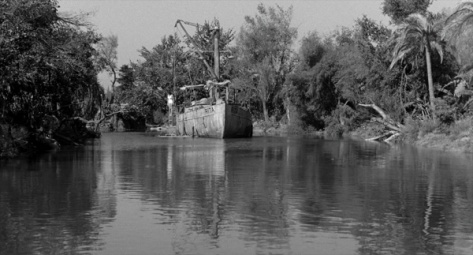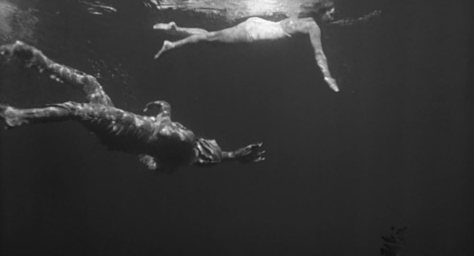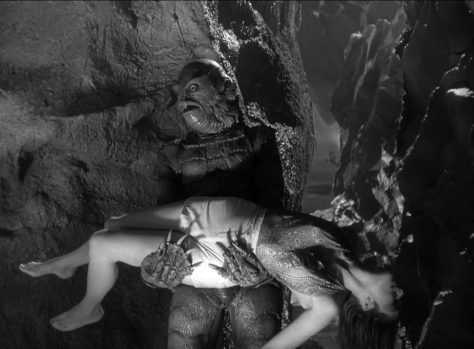
Most people seem to accept that Creature From the Black Lagoon is part of the classic Universal Monsters line-up, sitting alongside Dracula, Frankenstein, and the Mummy on home video covers, in theme park attractions, and on twelve-packs of soda and bags of potato chips—but in terms of context and content, it is at a removed from the films of the thirties and forties. Those films carried a certain Victorian literary flair (even when they ostensibly took place in “modern” times), set in a Gothic version of Europe (and maybe some other places) frozen in time, full of old foreboding castles and supernatural curses; the 1950s, often favoured science-based horror, and not the theatrical mad science of Frankenstein or The Invisible Man, but the kind that discovered and unleashed the atomic bomb, or that probed deeper into the prehistoric past or into outer space, and finding signs of man’s ultimate insignificance. In that sense, Black Lagoon is closer in spirit to its contemporaries, the less-commented-upon run of Sci-Fi monster movies put out by Universal that spanned everything from It Came From Outer Space and This Island Earth to Tarantula and even something like The Monolith Monsters. These films were about contemporary scientific thought—or, as close as movies like these actually get to it—and grapple with the idea that the more we learn about our universe, the more strange and terrifying it becomes, which is something a bit different from the otherworldly horrors of older stories.
But Black Lagoon still feels like a bridge between the “classic” monsters, which were gaining a new following thanks to television re-airings, and the new breed of mutants and space aliens haunting horror films—while the style of fifties-style monsters and the “classics” differed, that’s not to say that they were completely incompatible. This movies demonstrates that there are, in fact, many places where the two eras both diverge and meet: while steeped in the modern conventions and trends of the day, it maintains a good deal of the spirit of its predecessors, especially in characterizing its lead monster as an individual, tragic figure as well as a terrifying force. There is indeed a reason why this Creature gets to be part of the gang.

There’s a surprising rationality to how the movie presents itself, lacking all but the most minor allusions to the supernatural with its monster: while engaging in a few colonialist Darkest Jungle exploration tropes and telling us that even Lucas—yes, Lucas—has heard tales of the fish-man who haunts the Amazon, the monster is never treated as much of a mythical figure, and the scientists out looking for him—Richard Carlson (later in Valley of Gwangi) as David Reed, Julia Adams as Kay Lawrence, Whit Bissell as Dr. Edwin Thomas, and Richard Denning (also seen in Day the World Ended) as Mark Williams—don’t see him as one, either. The other pressing conflict of the story, as opposed to the one where multiple people are murdered by an amphibian monster, seems to be between Reed and Williams’ contrasting motivations: the former is a pure scientist who wants to document the Creature alive in its own habitat, while the latter is a glory-seeker who sees anything other than bagging undeniable proof as a profound personal failure (he has a spear gun at ready even before they knew a living specimen was still kicking around.) As fantastical as the movie’s premise is, the scientific aspect grounds it in a way that definitely contrasts it with the Gothic horror of the past, making its threat more about being outgunned by a little-understood animal (but one that is omnipresent and unrelentingly, hounding the characters constantly), rather than some unearthly abomination with powers beyond comprehension…which is not to say that the concept of it isn’t meant to carry some inherent horror to it.

In terms of scientific horror, Black Lagoon is about the concept of evolution—not evolution as science actually sees it, mind you, but the fanciful, broad version that the general public often gets (although it still seems to understand it better than an earlier movie like The Murders in the Rue Morgue, also technically a Universal horror movie)—using the image of a liminal organism, that which bridges the marine and the land animal, as something monstrous. While prehistoric creatures like dinosaurs have always been a major part of monster movie history, this presents something specifically about modern species’ relationship with its evolutionary past (people at the time probably had a passing understanding of the concept of a “missing link”), suggesting an alternative version of humanity that only barely left the water. Not only that, it also presents the creature, or Gill-Man as some people like to call him, as a relict individual, a species that managed to avoid further evolutionary change in millions of years like the Coelacanth (although they example the characters use is the lungfish)—in short, a ghost from prehistoric times still roaming the earth. In that way, this movie’s canonization with the other Universal monsters makes some sense: a prehistoric throwback is not unlike the living dead like Dracula or the Mummy, in that its a piece of history that refuses to leave the present alone.

All that said it still regularly wears the drive-in atmosphere of the fifties of it all on its sleeve (an unshakeable association seen in, of all things, the 1992 Bally pinball machine, which is 50% based on this movie and 50% based in pure 1950s nostalgia, even using “Rock Around The Clock” and other hit songs of the era as background music.) Those trends extend beyond just the theme of science-based horror: this originally released as a 3D film (just as the brief 3D movie craze was dying down), seen mostly in an opening volcanic eruption—where a quote from the book of Genesis transitions into descriptions of the beginnings of the Earth as science understands it, which feels like a pointed demonstration of how we view natural history has changed—and the underwater scenes. In the case of the latter sections, directed by Jim Havens, the 3D may have actually benefited the look, encouraging a mise-en-scene teeming with aquatic life and vast forests of vegetation, things that may be there to offer objects to pop out of the screen, but also create environments that are both active and foreboding. It probably helps that those scenes were shot in real wetland locations in Florida rather than in the usual Hollywood water tank.

Although the story by Maurice Zimm, Henry Essex, and Arthur Ross (based on a concept that producer William Alland came up with after hearing tales of Amazonian fish-men while working on Citizen Kane) is relatively simple, the film does have an atmosphere above and below the water line, a sense that even the learned people exploring this untouched piece of nature are completely out of their element. The monster has a tendency to pop up unexpectedly—this is not a movie that holds back on its selling point—and whether we see its webbed claws rising to the edges of solid land or its emotionless face peering behind a flowing wave of weeds, it has a constant presence that keeps tension high. The single most unsettling moment probably comes for the brief scenes where the crew thinks they have the Creature locked up, and we see it staring up at them from beneath the water-filled cage with its unblinking eyes distorted by the rippling water. The effectiveness of the visuals comes from director Jack Arnold, who among the genre filmmakers of the 1950s stands as one of the best, a person given B-Movie material and punching well above his weight class. Arnold is the true throughline for the line of Universal monster movies in the fifties, having directed It Came From Outer Space in 1953 and bringing a distinct quality (which in this case may have come from his time as a documentarian) to them just as directors like James Whale did in the thirties.

But as mentioned, one of the enduring legacies established by the classic Universal Monsters is in creating thoroughly iconic portrayals of their titular monsters, from acting to the design and make-up, and Black Lagoon certainly lives up to that. It has perhaps one of the most perfect and recognizable designs in the history of monster movies, just enough aspects of fish, amphibians, and humans to make this into a sleek and uncanny being that fully embodies its concept—there’s a reason why its design has been copied and parodied endlessly. Unlike a Frankenstein or Wolf Man, the Creature is rendered so completely inhuman (as many monsters of the fifties were) that the facial and vocal charisma of its actors doesn’t come out—its blank eyes and gasping breaths make close-ups of it especially creepy—instead, the movements and behaviour are what give it personality, essentially a pantomime performance. There’s a cleverly intentional contrast between the Creature on land, where it’s portrayed by Ben Chapman and has as awkward and animalistic gait (holding out its arms threateningly not unlike the Frankenstein Monster), and underwater, where the late stuntman/swimmer Ricou Browning gives it such effortless movement, it is both scary as a potential stalking predator and sort of beautiful as a life form perfectly suited to its environment.
The effectiveness of the monster is the result of numerous people, not just the actors in the suit and the people holding the cameras, but original designer Millicent Patrick, suit fabricator Jack Kevan, and Chris Mueller, who crafted the mask—all of whom were denied their proper credit for decades by Universal Make-Up Department head Bud Westmore (who even blocked Universal’s publicity department from touring Patrick around as “The Beauty Who Created The Beast.”) Mallory O’Meara’s 2019 non-fiction book The Lady From The Black Lagoon is an especially enlightening document on Patrick and the events surrounding the making of this movie.

The other aspect of the Creature’s character is just as reliant on the suit acting, especially Browning’s: the generally unstated romantic compulsion it has towards Julie Adams’ character. While monster/human romance is certainly a trope among the Universal monsters, it also feels like it’s leaning into ones established by their monster contemporary, King Kong (you could say Black Lagoon is simply the first half of Kong‘s story, with the second half given to its two inferior sequels.) The sequence where Kay and the monster parallel their balletic swimming movements at different depths is one the most famous, and it (alongside the monster’s gentler touch when dealing with her when compared to his propensity for throwing other people around like ragdolls) communicates the monster’s part in this story’s bizarre triangle—although it’s really more of a love…square?…considering that Kay is already sort of in a love triangle with Reed and Williams. Needless to say, this movie helped push the image of a monster carrying around a terrified actress into becoming a full-on trope, but for all the intentionally and unintentionally uncomfortable implications the monster lust concept has*, there’s still a degree of sympathy in the way that’s carried here, and that would go on to inspire people like Guillermo Del Toro, one of the untold number of filmmakers given the task of remaking this movie (effects master Rick Baker has apparently done designs for several of them) before the whole thing inevitably fell apart, who would then go on to expand on it further with his own movie.
*It is entirely possible that the Brazilian “fish-men” stories Alland heard were in fact the stories of Amazon River Dolphins, called encantados in Portuguese, sometimes said to shapeshift into human form in order to seduce people.

I guess if there’s one last thing that unites Black Lagoon with the older Universal monsters, it is that sense of sympathy. Despite everything, you never get the sense from either Reed or Kay that they want to see the monster harmed—in fact, Mark regularly tries to talk other people out of killing it; of all the cast, they seem to recognize not just its scientific significance, but also its strange and lonely existence as an animal out of time. In the inevitable final clash between man and monster (to save the girl, naturally), the men don’t hold back, but after stabbing and shooting the Creature until it staggers away, Mark chooses to let it return to its true home in the water for its final moments—it’s surprisingly respectful, not a simple triumph of humanity over some dumb monster (that still apparently holds the same beauty standards we do), and seems to tell us that, like Frankenstein and the Wolf Man, this is a monster whose end seems fated, but who did nothing to deserve our scorn.

